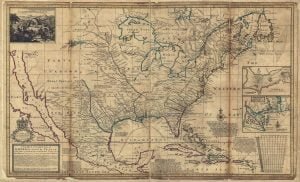
The name of the Keyauwee has no connection with that of Kecowee town of the Cherokee on Keowee River, in western South Carolina, nor apparently with that of Kiawah Island, south of Charleston. Of their language nothing remains, but the evidence of alliance and history goes to show that they were Siouan. They were never prominent as a separate tribe. In 1701 Lawson found them in a palisaded village about 5 miles beyond “Heighwaree” (Uharie) river, and near another stream which was probably Deep river. The village was about 30 miles northeast of the Yadkin, and must have been about the present High point in Guilford county, North Carolina. It was shut in by high hills or mountains, nearly bare of timber or grass, being composed of a reddish earth from which the Indians obtained their mineral paint. In one of these mountains was a large cave. Around the village were large fields of corn. At that time they were about equal to the Saponi in number, and were ruled by Keyauwee Jack, who was by birth a Congaree, but had obtained the chieftainship by marriage with the queen. Lawson describes the daughter of this queen as a beautiful girl, with an air of majesty not common among Indians. She treated his party kindly, and they were well entertained during their stay. Most of the men of this tribe wore mustaches or whiskers, which was not the general custom of the Indians, who usually plucked their beards.
Incidentally the traveler mentions that all the Indians of that neighborhood carefully preserved the bones taken out of the meat they ate and afterward burned them, believing that if this were not done the game would leave the country and they would have no more success in hunting. At this time they were about to join the Tutelo and Saponi for greater protection against their enemies.
In 1714 the Keyauwee, with the Saponi, Tutelo, Occaneechi, and Shoccoree, had moved down toward the settlements about Albemarle sound; all five tribes, together with one or two not mentioned, numbering only about 750 souls 1 . In 1716 Governor Spotswood proposed to settle the Keyauwee, with the Eno and Sara at Enotown, on the frontier of the North Carolina settlements, as already related, but was prevented by the opposition of that colony. Failing in this, they moved southward along with the Sara and probably also the Eno to Pedee river in South Carolina some time before 1733 2 . On Jefferys’ map of 1761 their village is marked on the Pedee above that of the Sara, and about on the line between North Carolina and South Carolina. We find no later mention of them, but like the two other tribes just named they were probably incorporated with the Catawba.
Keyauwee Synonymy
Keawee.- Bowen, Map of the British American Plantations, 1760.
Keeawawes.- Document of 1716 in Col. Records of N. C., 1886, p. 242.
Keeowaws.- lbid., p. 243.
Keeowee.- Vaugondy map, Partie de l’Amérique Septentrionale, 1755.
Keiauwees.- Lawson (1714), Hist. of Carolina, reprint 1860, p. 384.
Keomee.- Moll’s map of Carolina, 1720 (misprint).
Kewawees.- Byrd (1733), History of the Dividing Line, 1866, vol. ii, p. 20.
Keyauwees. – Lawson (1714), Hist. of Carolina, reprint 1860, p. 83.
Keyawees.- Brickell, Natural History of North Carolina, 1737, p. 343.
Citations:
- Lawson, John. The history of Carolina, containing the exact description and natural history of that country, etc., pp. 83, 87-92, 384. (Reprint from the London edition of 1714.) Raleigh, 1860.[↩]
- Byrd, William. History of the dividing line between Virginia and North Carolina, as run in 1728-’29, vol. ii, p. 20. Richmond, 1866. 2 volumes.[↩]
